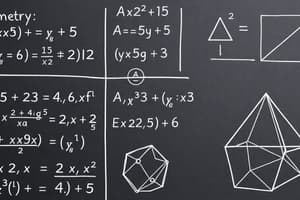Podcast
Questions and Answers
Which of the following equations represents a quadratic equation?
Which of the following equations represents a quadratic equation?
- 2x + 3 = 0
- 3x² - 2x + 1 = 0 (correct)
- x - 4 = 3
- y = 5x + 2
What is the standard form of a linear equation?
What is the standard form of a linear equation?
- y = mx + b (correct)
- y = ax² + bx + c
- mx + b = 0
- ax² + bx + c = 0
Which of the following represents a method for finding the area of a triangle?
Which of the following represents a method for finding the area of a triangle?
- rac{1}{2} × base × height (correct)
- length × width
- base + height
- rac{4}{3}π × radius³
What is the Pythagorean Theorem used for?
What is the Pythagorean Theorem used for?
Which measure of central tendency is defined as the most frequently occurring value in a data set?
Which measure of central tendency is defined as the most frequently occurring value in a data set?
What type of probability is calculated using the outcomes of independent events?
What type of probability is calculated using the outcomes of independent events?
What is the volume formula for a sphere?
What is the volume formula for a sphere?
What is a key characteristic of a function?
What is a key characteristic of a function?
Flashcards are hidden until you start studying
Study Notes
Algebra
-
Basic Concepts:
- Variables: Symbols representing numbers (e.g., x, y).
- Constants: Fixed values (e.g., 2, -5).
- Expressions: Combinations of variables and constants (e.g., 2x + 3).
-
Equations:
- Linear Equations: Form y = mx + b, where m is the slope and b is the y-intercept.
- Quadratic Equations: Form ax² + bx + c = 0; solved using factoring, completing the square, or quadratic formula.
-
Functions:
- Definition: A relation where each input has a single output.
- Types: Linear, quadratic, polynomial, exponential, logarithmic.
-
Factoring:
- Techniques: Grouping, difference of squares, trinomials.
- Importance: Solves equations and simplifies expressions.
Geometry
-
Basic Principles:
- Points, Lines, Line segments, and Rays: Fundamental elements of geometry.
- Angles: Measured in degrees; types include acute (<90°), right (90°), obtuse (>90°).
-
Shapes and Forms:
- Two-dimensional (2D): Circles, triangles, rectangles, quadrilaterals.
- Area Formulas:
- Triangle: ( \frac{1}{2} \times base \times height )
- Rectangle: ( length \times width )
- Circle: ( \pi \times radius^2 )
- Area Formulas:
- Three-dimensional (3D): Spheres, cubes, cylinders.
- Volume Formulas:
- Sphere: ( \frac{4}{3} \pi \times radius^3 )
- Cube: ( side^3 )
- Cylinder: ( \pi \times radius^2 \times height )
- Volume Formulas:
- Two-dimensional (2D): Circles, triangles, rectangles, quadrilaterals.
-
Theorems:
- Pythagorean Theorem: In right triangles, ( a^2 + b^2 = c^2 ), where c is the hypotenuse.
Statistics
-
Descriptive Statistics:
- Measures of Central Tendency: Mean, median, mode.
- Measures of Dispersion: Range, variance, standard deviation.
-
Probability:
- Definition: Measure of likelihood, ranging from 0 to 1.
- Types: Independent, dependent events; complementary events.
-
Data Representation:
- Graphs: Bar charts, histograms, pie charts, line graphs.
- Tables: Organize data for easier analysis.
-
Inferential Statistics:
- Uses sample data to draw conclusions about a population.
- Techniques: Hypothesis testing, confidence intervals, regression analysis.
Algebra
- Variables: Symbols representing unknown numbers.
- Constants: Fixed numerical values that don't change.
- Expressions: Combinations of variables, constants, and mathematical operations.
- Linear Equations: Have the form y = mx + b, where m is the slope and b is the y-intercept.
- Quadratic Equations: Have the form ax² + bx + c = 0, solved using factoring, completing the square, or the quadratic formula.
Functions
- Definition: A relationship where each input has a unique output.
- Types: Linear, quadratic, polynomial, exponential, and logarithmic functions.
Factoring
- Grouping: A technique used to factor expressions with four or more terms by grouping terms with common factors together.
- Difference of Squares: A technique used to factor expressions in the form a² - b² as (a + b)(a - b).
- Trinomials: Expressions with three terms, commonly factored as (ax + b)(cx + d).
- Importance of Factoring: Simplifies expressions and helps solve equations.
Geometry
- Basic Elements:
- Points: Locations in space.
- Lines: Extend infinitely in both directions.
- Line Segments: Finite portions of lines.
- Rays: Start at a point and extend infinitely in one direction.
- Angles:
- Measured in degrees.
- Acute Angles: Less than 90°.
- Right Angles: Equal to 90°.
- Obtuse Angles: Greater than 90°.
Shapes and Forms
- 2D Shapes:
- Circles: Closed curves with all points equidistant from a center point.
- Triangles: Three-sided polygons.
- Rectangles: Four-sided polygons with four right angles.
- Quadrilaterals: Four-sided polygons.
- Area Formulas:
- Triangle: ( \frac{1}{2} \times base \times height )
- Rectangle: ( length \times width )
- Circle: ( \pi \times radius^2 )
- 3D Shapes:
- Spheres: Three-dimensional objects with all points equidistant from a center point.
- Cubes: Six-sided shapes with all sides equal in length.
- Cylinders: Three-dimensional objects with two circular bases and parallel sides.
- Volume Formulas:
- Sphere: ( \frac{4}{3} \pi \times radius^3 )
- Cube: ( side^3 )
- Cylinder: ( \pi \times radius^2 \times height )
Theorems
- Pythagorean Theorem: In a right triangle, the square of the hypotenuse (the side opposite the right angle) is equal to the sum of the squares of the other two sides. ( a^2 + b^2 = c^2 ).
Statistics
- Descriptive Statistics: Summarizes and describes data.
- Measures of Central Tendency:
- Mean: Average of a dataset.
- Median: Middle value in a sorted dataset.
- Mode: Most frequent value in a dataset.
- Measures of Dispersion:
- Range: Difference between the largest and smallest values in a dataset.
- Variance: Average squared deviation from the mean.
- Standard Deviation: Square root of the variance.
- Measures of Central Tendency:
Probability
- Definition: Measures the likelihood of an event occurring between 0 and 1.
- Independent Events: Events that do not influence each other.
- Dependent Events: Events where the outcome of one event affects the outcome of another.
- Complementary Events: Two events that are the only possible outcomes. The probability of one event is 1 minus the probability of the other.
Data Representation
- Graphs:
- Bar Charts: Visualize categorical data with rectangular bars.
- Histograms: Visualize numerical data with adjacent bars.
- Pie Charts: Visualize proportions of a whole.
- Line Graphs: Show trends in data over time.
- Tables: Organize data for easier analysis and interpretation.
Inferential Statistics
- Uses: Draws conclusions about a population based on a sample.
- Techniques:
- Hypothesis Testing: Uses sample data to test a claim about a population.
- Confidence Intervals: Estimate a range of values for a population parameter.
- Regression Analysis: Examines the relationship between variables.
Studying That Suits You
Use AI to generate personalized quizzes and flashcards to suit your learning preferences.





